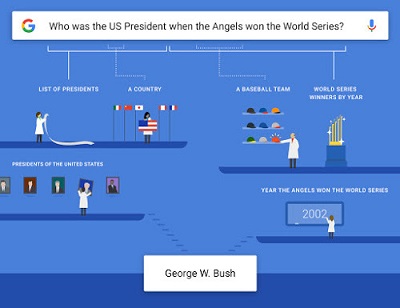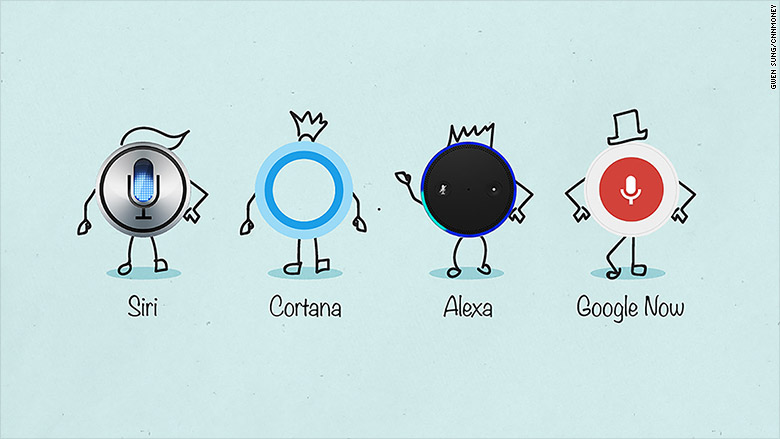Mobile Keywords: Hitting a Moving Target

-
Make sure that each of your individual content campaigns is targeted and optimized. This should ensure your content gets on the right screens and in front of the right eyes.
-
Keep your content campaigns individually targeted. Keep them specific and actionable. And start building relationships between your different pieces.
-
Mobile search is reliant on Google’s Knowledge Graph and prefers related posts that are easily shared and promoted. So building connections between your disparate pages will improve your rankings.
Mobile Strategy: Fork in the Content Roadmap

How Semantic Search Works
-
User’s search intent (the best guess of what the user wants)
-
Context of the search (prior activity on a search engine)
-
Related searches (other search terms connected)
-
Suggested search (most popular related google suggest queries)

Multiple Content Campaigns
In order to optimize for the Knowledge Graph’s connection friendly ranking algorithms, map out your content campaigns with different branches that connect your disparate pieces.
For example, if you have a piece on “how view-through conversions can affect your attribution metric,” you should also have pieces on “attribution and ROI as a whole,” and a piece “comparing view through to click-through conversions.”

This way you have three different pieces that are all related to one another. Ideally, they will also be interlinked to one another through a strong internal linking strategy. Now, when a user types in a search related to attribution, you have three posts the Knowledge Graph can prioritize instead of just one.
Mobile Linking: Content Networking – It’s a Thing
You need your different pieces of content to work together and for one another to get each of your pieces the visibility it deserves. Today’s search engines value connections – so get to forging some.

Connecting Your Campaigns
Having multiple branches of your campaigns that trace back to your primary keywords will also help you target the long tail modifications of those keywords.
Advanced keyword tactics like chasing the long tail or sourcing sites like Answer the Public for interrogative keyword variations will diversify the searches you rank for. This should help you tackle more of the market share for individual SERPs as well.
But, true mobile optimization comes with connecting your different pieces of content to make them more shareable and social friendly.

As opposed to regular content campaigns where you can rely on backlinks and SEO ranking to increase your visibility, mobile content is dispersed primarily through sharing instead of linking. This re-prioritizes how you write your content. Especially when coupled with Google’s mobile-first algorithm that prioritizes direct, simplified answers.
Instead of focusing on repeating the keywords that are entered into the search bar, you now need to be answering the actual questions asked.
This is why aiming for the Featured Snippet has become the goal of many an SEO agency, where the top 3 SERP rankings use to be enough.
Optimizing for Social
Instead of working with keywords, play around with your meta descriptions and offer your readers specific “sneak peeks” of what the piece offers.
A recent study showed that there is a weak correlation between reads and share time. Over 60% of shares occur without actually reading the post. This means that people are sharing without actually reading your piece – better make that featured image and display ad tantalizing enough to share without ever even being clicked on.
When your content’s promotion is reliant on social media platforms, you need to tailor the format of your display ads as well as your copy to better account for mobile attention spans.
Making sure that your pieces are well connected to one another both through linking and subject matter will help you impress the Knowledge Graph.
Keeping your title tags and meta descriptions directed and answer driven for user queries, along with using awesome creatives for your display ads, will increase shareability – which drives a large portion of mobile discovery today.
Lastly, attacking more semantic phrasings for topics instead of relying on a generic keyword that is unnatural to the actual conversation will help you adapt to more natural user-search engine interactions.
Mobile Results: Stingy Mobile Searches
The increased mobilization of search has had a strong influence on the way we search marketers to perform keyword research and strategize our content roadmaps. It’s had greater effects, still, on the way, we promote our content and target niche users.
But the biggest game-changer to mobile search by far is the single result mobile SERP panel.

Single Result mobile SERPs
Google recently threw another curveball at us mobile search marketers with its implementation of the Gboard. The customized keyboard links Google’s mobile-first algorithms with its predictive search capabilities.
The Gboard is a Google infused keyboard, simply put.
What is significant about the GBoard, however, is that it has a default preference for Knowledge Graph answers and Featured Snippets. That means that connected content, as well as direct answers and definitions, take priority for Google’s mobile SERPs. And with the Gboard, the real estate value of that SERP has never been higher.

Notice anything funny about the mobile SERP above? Like how there is only one ?!
Yup. That’s right. The Gboard’s mobile SERP has only a single result on the display at a time within the SERP carousel. This means aiming for page 1 of the SERP, or the top five results on page 1, won’t cut it anymore.
With over half of all search interactions beginning on a mobile device, you need to know how rank and convert on mobile SERPs.
And that means knowing how to get to the top result for a mobile search query.
Voice Search
You wouldn’t have thought, back when you first heard Siri’s voice, that digital assistants like her would be revolutionizing the search marketing industry. But Siri, Cortana, Alexa, and Google Now are drastically changing the way mobile users interact with search engines.
Think of the difference between a typed-in keyword search and you asking Siri a question.

Semantic search is overtaking keyword searches through Digital assistants and voice search capabilities. The more naturalized Google’s language processing software becomes, the more question-answer based SERPs are going to become.
Featured snippets and the Knowledge Graph are just the beginning.
Voice search emphasizes the user intent behind certain queries. So it is especially focused on providing you with answers instead of just a list of possible links to choose from.

Syntax of Semantic Search
Voice search is also starting to work both ways. Google is now allowing for audio advertisements in response to their lack of paid ads featured on the Gboard. These also combine with local ads.
The most obvious change to search optimization that comes with voice search is also the issue that is plaguing content marketers struggling with semantic search. Google’s language algorithms are learning to account for a natural language better and better.
Instead of optimizing your pages for “local SEO agency” keywords, you need to be answering the question “What are the best digital marketing agencies in Orange County?” or “What are the different pricing models for local PPC agencies?”
Whenever you are facing doubt as to whether you have developed written the right content or ad copy, just remember this simple question: “what would you click on?”
Mobile Behavior: Impressing “Phone-Drones with College Loans”
So we’ve addressed the different ways in which mobile search has changed the way we content marketers conduct our research, strategize our campaigns, promote our content, and optimize for volatile SERPs. Now let’s take a look at how mobile culture has affected our readership.
Natural VS Unnatural Language
Here is an interesting paradox that few content marketers have addressed. Search algorithms are working their hardest to more closely align with natural language. While at the same time the mobile user is distancing himself/herself from natural language further each day.
Texting shorthand, giphy memes, and emojis are all being implemented in different mobile and online marketing campaigns.
For some time now, certain less-than white hat paid campaigns have been paying for misspelled variations of their keywords to steal misdirected traffic. And certain search marketers are learning how to optimize their title tags. You can increase click-through rate conversions by ditching your brand name and using parentheses to offer readers a “sneak peek” of the content.
There are even Facebook retargeting campaigns that use emojis in the title tag to help disrupt the reader and get their attention.

Optimizing your content development around the mobile-immersed user doesn’t mean optimizing for Google’s newest implementation at every turn. It means optimizing the way users are interacting with that new feature.
If you optimized for semantic search alone, instead of how users are using text shorthand and emojis within semantic search, you would miss the point entirely.
Inspiring Participation
Many marketers mistakenly conflate the increase in social media popularity with the specific millennial generation. While mobile reliance is more of a technological development than a generational one, understanding the generation that grew up with those developments can provide some helpful insights.
(To avoid making the same mistake, I’ll use the term ‘social media users’ instead of ‘millennials.’)

Social media users value participation and customization in their online interactions. Even if they are small features like tagging in to locations or customizing their own hashtags for a certain topic, they want to feel involved with action – not just ideas.
This is why implementing social friendly concepts into your content – and into your stores if you are a local retail business – is so important. Offering opportunities to customize their experience by integrating their own personal social media accounts can really increase an individual’s engagement with a piece.
Forging a personal connection is a great way to bolster a strong following instead of just a one time interaction.
Mobile Lingo: “Gen teXt” and the Language of the Future
Just because you can use emojis and text shorthand in your content (sparingly!) now to play off of the social media angle, does NOT mean you are performing keyword research on “lol” or trying to optimize your use of the crying laughter emoji.
The basis of mobile marketing strategy today is that mobile search technology is steadily eliminating the divide between what a user “says” and what a user “wants.” So, don’t optimize your content for what was typed into the search bar. Instead, you need to be optimizing for what the person is actually looking for.
Mobile search marketing is far more of a conversation than it is a reading experience.
You should be formatting your blog copy, your promotion strategy, and your optimization tactics to better align each of themselves with the idiosyncrasies of your ideal user.
Mobile users are the customers of the future – starting speaking their language.
-
 CEO
Garrett Mehrguth
CEO
Garrett Mehrguth
Did you enjoy this article?
Share it with someone!
